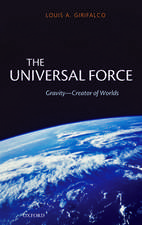Gravitational Lensing: Proceedings of a Workshop Held in Toulouse, France September 13–15, 1989: Lecture Notes in Physics, cartea 360
Editat de Yannick Mellier, Bernard Fort, Genevieve Soucailen Limba Engleză Paperback – 20 noi 2013
Din seria Lecture Notes in Physics
- 19%
 Preț: 423.99 lei
Preț: 423.99 lei - 17%
 Preț: 360.73 lei
Preț: 360.73 lei -
 Preț: 429.22 lei
Preț: 429.22 lei - 17%
 Preț: 427.62 lei
Preț: 427.62 lei - 17%
 Preț: 460.25 lei
Preț: 460.25 lei -
 Preț: 427.96 lei
Preț: 427.96 lei -
 Preț: 481.93 lei
Preț: 481.93 lei - 17%
 Preț: 494.64 lei
Preț: 494.64 lei -
 Preț: 281.90 lei
Preț: 281.90 lei - 17%
 Preț: 493.20 lei
Preț: 493.20 lei - 17%
 Preț: 426.72 lei
Preț: 426.72 lei -
 Preț: 365.15 lei
Preț: 365.15 lei -
 Preț: 374.52 lei
Preț: 374.52 lei -
 Preț: 407.98 lei
Preț: 407.98 lei - 20%
 Preț: 428.12 lei
Preț: 428.12 lei -
 Preț: 263.30 lei
Preț: 263.30 lei - 15%
 Preț: 593.73 lei
Preț: 593.73 lei - 15%
 Preț: 528.13 lei
Preț: 528.13 lei -
 Preț: 493.12 lei
Preț: 493.12 lei - 17%
 Preț: 425.68 lei
Preț: 425.68 lei -
 Preț: 280.65 lei
Preț: 280.65 lei -
 Preț: 163.41 lei
Preț: 163.41 lei - 18%
 Preț: 726.59 lei
Preț: 726.59 lei -
 Preț: 394.84 lei
Preț: 394.84 lei - 15%
 Preț: 709.63 lei
Preț: 709.63 lei - 15%
 Preț: 623.90 lei
Preț: 623.90 lei - 20%
 Preț: 476.91 lei
Preț: 476.91 lei - 15%
 Preț: 428.05 lei
Preț: 428.05 lei -
 Preț: 342.78 lei
Preț: 342.78 lei - 18%
 Preț: 851.93 lei
Preț: 851.93 lei -
 Preț: 346.61 lei
Preț: 346.61 lei -
 Preț: 391.57 lei
Preț: 391.57 lei - 15%
 Preț: 633.16 lei
Preț: 633.16 lei -
 Preț: 451.71 lei
Preț: 451.71 lei - 5%
 Preț: 1497.80 lei
Preț: 1497.80 lei -
 Preț: 374.85 lei
Preț: 374.85 lei -
 Preț: 380.07 lei
Preț: 380.07 lei - 15%
 Preț: 516.14 lei
Preț: 516.14 lei - 15%
 Preț: 583.78 lei
Preț: 583.78 lei - 15%
 Preț: 508.60 lei
Preț: 508.60 lei -
 Preț: 469.71 lei
Preț: 469.71 lei -
 Preț: 388.90 lei
Preț: 388.90 lei - 15%
 Preț: 500.24 lei
Preț: 500.24 lei -
 Preț: 386.52 lei
Preț: 386.52 lei - 15%
 Preț: 472.88 lei
Preț: 472.88 lei -
 Preț: 424.27 lei
Preț: 424.27 lei -
 Preț: 380.07 lei
Preț: 380.07 lei - 15%
 Preț: 500.01 lei
Preț: 500.01 lei
Preț: 644.63 lei
Preț vechi: 758.38 lei
-15% Nou
Puncte Express: 967
Preț estimativ în valută:
123.35€ • 129.11$ • 102.67£
123.35€ • 129.11$ • 102.67£
Carte tipărită la comandă
Livrare economică 31 martie-14 aprilie
Preluare comenzi: 021 569.72.76
Specificații
ISBN-13: 9783662137833
ISBN-10: 3662137836
Pagini: 336
Ilustrații: XV, 318 p.
Dimensiuni: 170 x 244 x 18 mm
Greutate: 0.54 kg
Ediția:Softcover reprint of the original 1st ed. 1990
Editura: Springer Berlin, Heidelberg
Colecția Springer
Seria Lecture Notes in Physics
Locul publicării:Berlin, Heidelberg, Germany
ISBN-10: 3662137836
Pagini: 336
Ilustrații: XV, 318 p.
Dimensiuni: 170 x 244 x 18 mm
Greutate: 0.54 kg
Ediția:Softcover reprint of the original 1st ed. 1990
Editura: Springer Berlin, Heidelberg
Colecția Springer
Seria Lecture Notes in Physics
Locul publicării:Berlin, Heidelberg, Germany
Public țintă
ResearchCuprins
Pictures of gravitational lensing.- Determination of cosmological parameters by the gravitational lens effect.- Cosmic gravitational diagnostics.- Gravitational redshifts and lensing by large scale structures.- What the present observed lens systems tell about the lensing agent.- Gravitational lens models with elliptical geometry.- Amplification near a gravitational lens macro-caustic.- Statistics of lensing on extended sources.- Observational aspects of gravitational lensing.- Quasar-galaxy associations.- A search for gravitational lensing among highly luminous quasars : observational strategy and survey.- A search for gravitational lensing among highly luminous quasars: new results.- Gravitational magnification effects on distant 3CR galaxies.- 0957+561: The time delay revisited.- The time delay of Q0957-+-561 A,B from 10 years of optical monitoring.- Application of image processing techniques in a search for gravitational lenses and quasar pairs.- A search for gravitational lenses and quasar pairs and the discovery of a new multiple QSO system.- Evolution and gravitational lensing in quasar absorption line systems.- Preliminary analysis of high-resolution spectra for UM 673 A & B.- Bidimensional spectrography of the “clover leaf” H1413+117 at sub-arcsec. Spatial resolution.- The MIT search program for gravitational lenses.- First epoch VLBI observations of the gravitational lens system 2016+112.- X-ray observations of gravitational lenses.- Consequences of gravitational lensing for gamma radiation from 3C273.- Searching for cosmic strings (A la recherche des cordes perdues).- Microlensing.- Microlensing calculations with a hierarchical tree code: New results.- Statistical investigations of the amplification near gravitational lens caustics.- The deconvolution ofthe quasar structure from the lightcurve of a high amplification event with the regularisation method.- The Hamburg quasar monitoring program at Calar Alto: Analyses of micro-lensing variability.- Photometric monitoring of 2237+0305.- Spectrophotometry of 0957+561 and the micro-lensing effect.- IR imaging and the light curve of 2237+030.- Clusters of galaxies: A new observable class of gravitational lenses.- Lensing the background population of galaxies.- The redshift distribution of faint galaxies — Implications for gravitational lensing.- The theory and practice of radio ring lenses.- Lens and source models for ARCS in cluster Abell 370 and Cl 2244.- Modeling the giant arcs in A370 and A2390.- New results from the gravitational telescope.- Probing rich galaxy clusters with mini-arcs.- Gravitationally lensed arcs as galaxy redshift indicators.- Spatial correlation in gravitationally lensed images.- Optical-infrared studies of arcs in Abell 370.- Spectroscopy of arcs in Cl2244-02 and A370 (A5).- First results on the spectroscopy of the arc-like object in Abell 2390.- Deep photometry of C1.2244-02 in U colour with an electronographic camera.- Concluding remarks.- Gravitational lens candidates.















